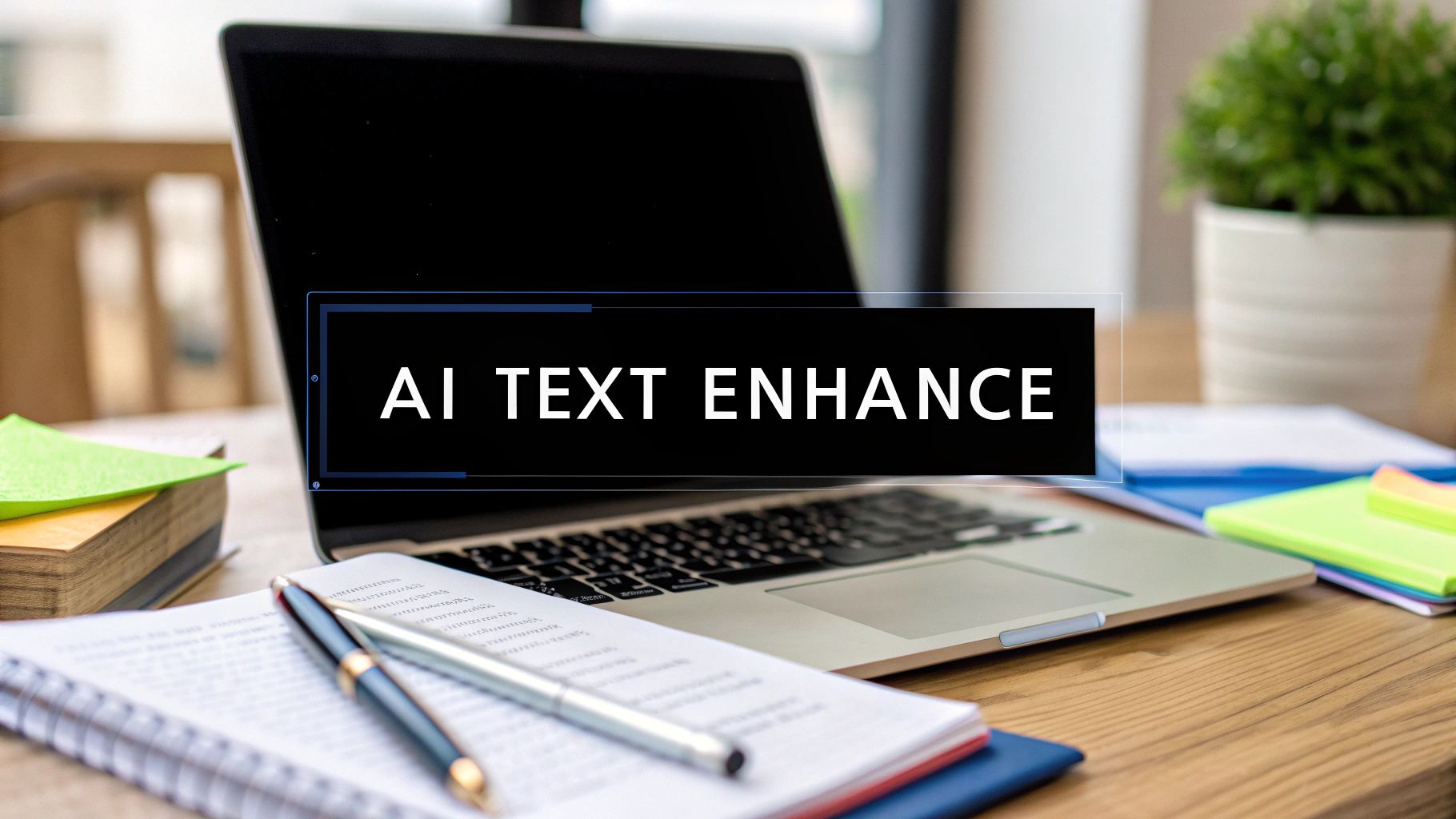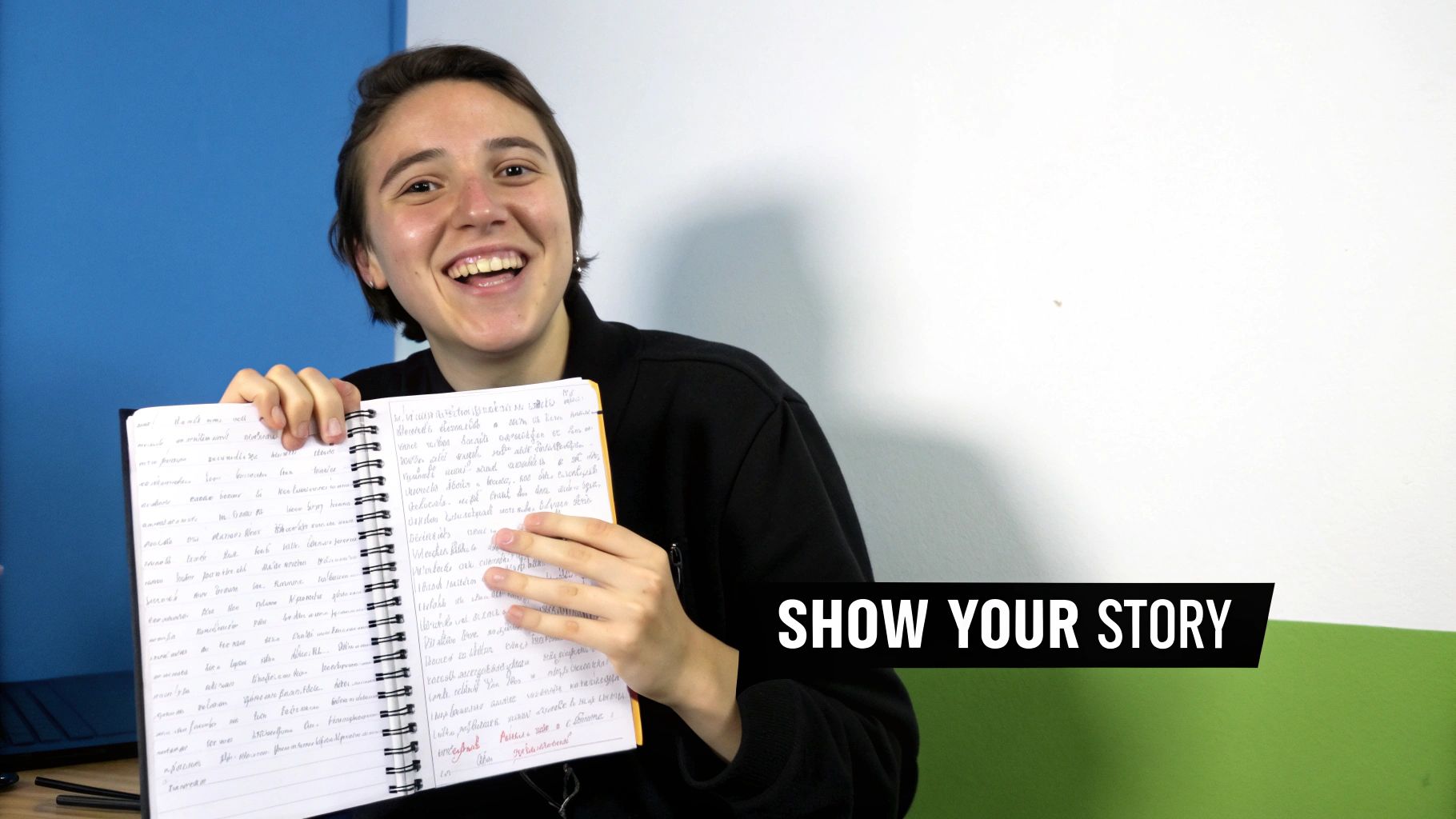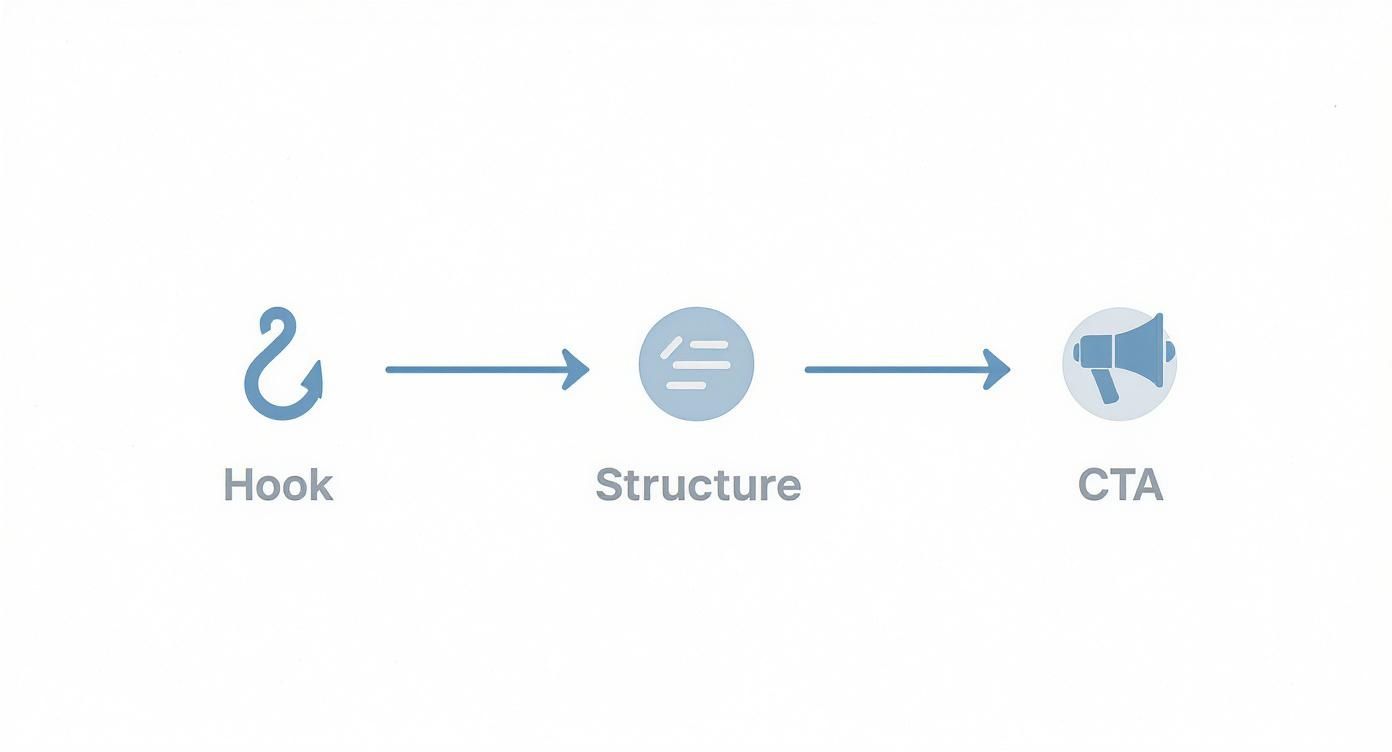
AI Text Enhance for Powerful LinkedIn Posts
Published on 2025-11-16
When you use an AI tool to "enhance" text, you're really just taking the raw, machine-generated draft and injecting your own human touch into it. It's the process of refining, editing, and personalizing that initial output so it sounds like you—not a robot. This is how you transform generic text into something that actually connects with people.
Why Raw AI Content Fails on LinkedIn

AI content generators are fantastic for getting ideas on paper and spitting out a first draft. But if you just copy and paste that directly to LinkedIn, you're setting yourself up for failure.
The audience on LinkedIn is looking for genuine expertise and authentic connection. Unedited AI text just doesn't deliver that. What you often get is something that’s grammatically flawless but completely devoid of personality.
The Tell-Tale Signs of Unedited AI
You’ve seen these posts. You can just feel they were written by an AI before you even finish the first sentence. The signs are usually subtle, but they're enough to make your audience keep scrolling.
Here’s what to look out for:
- Generic Platitudes: AI models are trained on the entire internet, so they tend to lean on clichés and tired phrases. Think "In today's fast-paced world..." or "It's crucial to think outside the box."
- No Personal Perspective: An algorithm can't tell a story about that one time a project went completely off the rails and what you learned from it. It's this missing layer of real-world experience that makes AI content feel hollow.
- A Robotic Tone: The writing often feels unnatural. Sentences might be the same length, or the word choice is overly formal and stuffy. It misses the conversational rhythm of how real people talk.
The goal isn’t to let AI replace your voice. It’s to use it as a powerful assistant that helps amplify your unique insights and build a personal brand that starts real conversations.
The massive growth in this technology shows just how important it's becoming. The global AI market was valued at a staggering USD 638.23 billion in 2024. Machine learning, the engine behind these tools, makes up the biggest slice of that pie at 36.70%.
This investment signals that AI is here to stay, but making it truly effective still requires a human in the driver's seat. You can read more about the growth of the artificial intelligence market to see just how fast things are moving.
Mastering Prompts for Better AI Drafts
https://www.youtube.com/embed/qBlX6FhDm2E
If you want to get anything worthwhile out of an AI, you've got to get good at writing prompts. It's as simple as that. Vague instructions will always get you generic, unusable content. The trick is to stop thinking of AI as a magic box and start treating it like a very capable, very literal assistant who needs clear, specific directions to do its job well.
Think about it. Asking an AI to "write about AI in marketing" is like telling a new hire to "go do some marketing." You’ll get something back, but I guarantee it won't be what you had in mind. The quality of what you get out is a direct reflection of what you put in.
We're seeing this play out in real-time as generative AI tools explode in popularity. The market for this tech was already valued at around USD 44.89 billion in early 2025, a huge leap from USD 29 billion back in 2022. Tools like ChatGPT, which pulled in a staggering 525.9 million unique visitors in March 2025 alone, are everywhere. But they all run on the same fuel: your prompts.
The Anatomy of a Powerful Prompt
When I'm drafting a prompt for a LinkedIn post, I make sure it has three key ingredients. Nail these, and the AI will give you a draft that’s much closer to the finish line right from the start.
Define a Persona: First, tell the AI who it is. Don't let it default to that bland, robotic voice. Give it a personality. Something like, "Act as a pragmatic CTO who’s great at breaking down complex tech concepts for a non-technical audience."
Set a Clear Objective: What's the point of the post? What do you want people to do, think, or feel after reading it? Be specific. For instance, "My goal is to make people curious about our upcoming webinar on cybersecurity for small businesses."
Provide Unique Context: This is where the magic happens. The AI has no access to your personal stories, your company's data, or your unique take on the industry. You have to feed it those details. Mention a specific client win, a surprising stat you stumbled upon, or a lesson you learned the hard way.
A great prompt isn't about writing a novel; it's about providing the right details. You're giving the AI the raw materials it can't invent—your personal expertise and your unique point of view.
Prompt Enhancement From Basic to Advanced
Let's look at what this means in practice. A tiny bit of detail can transform the AI's output from generic fluff to a compelling, story-driven post.
The table below shows a side-by-side comparison of a weak prompt versus a strong one.
Prompt Enhancement From Basic to Advanced
| Prompt Element | Basic Prompt Example | Enhanced Prompt Example |
|---|---|---|
| Persona | Write a LinkedIn post. | Act as a seasoned B2B sales leader with a friendly, mentor-like tone. |
| Objective | Talk about cold outreach. | Convince young sales reps that personalized cold outreach is still effective. The goal is to get comments sharing their own experiences. |
| Context | Mention that it's hard but rewarding. | Include my personal anecdote about how a single, well-researched cold email I sent in 2019 landed our company's biggest client to date. Emphasize research over volume. |
See the difference? The basic prompt will spit out a generic list of tips you've seen a hundred times. But the enhanced prompt will generate a post built around a real story, with a clear perspective and a specific call to action. That’s a foundation you can actually build on.
If you're looking for a more specialized starting point, using an AI Post Generator specifically for LinkedIn can help tailor the output even further. To explore more options, check out our guide on the best AI content creation tools.
Injecting Your Authentic Voice

You’ve got a solid first draft from the AI. Great. Now comes the part that actually matters—making the content sound like you.
An AI can assemble facts and follow a structure, but it can’t tap into your unique perspective. It doesn't know about that one project that taught you a hard lesson or the killer anecdote that always gets a reaction. This is where you switch hats from a prompt engineer to a storyteller.
Your goal here is to transform a generic piece of text into a genuine conversation starter, one that builds real trust with the people in your network.
Ditch General Claims for Specific Stories
The biggest tell of AI content is its love for broad, generic statements. You’ll get lines like, "Effective leadership is crucial for team success." It's not wrong, but it’s completely forgettable. Your job is to replace these platitudes with real-world proof.
Instead of that bland sentence, think about a real moment. Maybe something like this: "Last quarter, our biggest project was on the brink of failure. I learned more about real leadership in that one stressful week of turning things around than in any management course I’ve ever taken."
See the difference? This simple tweak immediately accomplishes three things:
- It builds credibility. You’re showing you’ve actually been there.
- It creates a connection. People relate to stories, not generic business jargon.
- It’s memorable. We're wired to remember narratives far better than abstract facts.
Get into the habit of doing a quick "authenticity audit." Read through the draft and ask yourself, "Could literally anyone have written this, or does it sound like me?" If it's the former, it’s time to start adding your personal flavor.
Weave in Your Unique Data and Perspective
Your AI doesn't know about your company's internal wins, your personal case studies, or the slightly unconventional opinions you've formed after years in the trenches. This is your secret weapon.
Did you recently uncover a surprising piece of data from a customer survey? Drop it in. Do you have a contrarian view on a hot industry trend? Share it and explain your reasoning. This is your chance to offer value that no one else can. To really make AI content feel original, you need a few practical tricks up your sleeve, much like those discussed when learning how to humanize AI text.
Match the Cadence to Your Speaking Voice
Here’s a simple but powerful final step: read the entire post out loud. Seriously. Does it sound like something you'd actually say to a colleague over coffee? AI writing often defaults to a slightly stiff, overly formal tone. Now's the time to loosen it up.
- Chop up those long, winding sentences into shorter, punchier ones.
- Use contractions like "it's" and "you're" if that's how you normally talk.
- Swap out stuffy corporate jargon for the simpler words you use every day.
This final polish is what makes the post truly align with your personal brand. If you want to get really deliberate about this, our guide on developing brand voice guidelines offers a more structured way to stay consistent. This is the step that closes the gap between a technically correct post and one that actually connects with people.
Editing for Readability and Engagement
A brilliant message is worthless if nobody reads it. Let's be honest, people on LinkedIn scroll fast. Your post's structure is just as crucial as its content, and an unedited AI draft often spits out a dense "wall of text." That’s an instant "skip" for anyone with a busy feed.
This isn't about just catching typos. It’s about strategically shaping your post to grab and hold onto a reader's attention. You want your content to be scannable, easy to digest, and frankly, inviting. This is where you add that human polish that turns a decent draft into a post that actually performs.
Getting this right is more important than ever. The technology behind these AI writers, Natural Language Processing (NLP), is on track to become a nearly USD 14.84 billion market by 2025. That tells you a lot of automated text is flooding our feeds, but it also means that the human touch is what will make content stand out. You can dig into more data about the worldwide NLP market on Statista.
Nail the Opening Hook
Your first sentence has one job and one job only: get them to read the second sentence. You have just a couple of seconds to stop the scroll, so a generic AI opener is the fastest way to get ignored.
Don't just state a fact. Grab them by the collar.
Try one of these angles:
- Ask a challenging question: "What if your entire client retention strategy is built on a myth?"
- Lead with a shocking number: "More than 70% of sales teams miss quota. The real reason is hiding in plain sight."
- Share a bold, contrarian take: "Forget 'finding your passion.' It's some of the worst career advice you'll ever get."
A hook like this creates an "information gap." It piques their curiosity and pulls them down the page to find the answer.
Before: "It is important for businesses to adapt to new technologies to stay competitive." After: "My biggest competitor went out of of business last year. The reason why is a warning for every company still clinging to outdated tech."
Use White Space as a Weapon
Huge blocks of text are a nightmare, especially on a phone. The secret to making your writing readable is to break. it. up.
Keep your paragraphs short. I’m talking one to three sentences, max. This simple trick forces you to be punchy and gives the reader's eyes a place to rest. All that white space makes your content feel less like a textbook and more like a conversation.
Make Your Post Scannable
Look, most people on LinkedIn aren't reading every single word. They’re scanning for the good stuff. Your job is to make the good stuff easy to find.
Use formatting to your advantage to highlight the key takeaways:
- Bullet Points: Perfect for listing out benefits, features, or quick tips. They let you share multiple ideas without creating a wall of text.
- Numbered Lists: These are your go-to when you're explaining a process, sharing a ranking, or laying out a sequence. The numbers give a clear sense of progression.
These aren't just decorative; they make your ideas much easier to grasp at a glance.
Finally, tell your reader what to do next with a strong Call-to-Action (CTA). Ditch the lazy "Share your thoughts." Ask a specific, interesting question that genuinely invites a thoughtful response. A great CTA doesn't feel like a command—it feels like the start of a real conversation, sparking comments and driving real engagement.
Building an Efficient Enhancement Workflow
Let's be honest, any tool is only as good as the process you build around it. Using AI to help with your LinkedIn posts is no different. If you just jump in without a plan, you'll probably spend more time wrestling with generic drafts than you save. We all know consistency is crucial on LinkedIn, but you can't sacrifice quality just to post more often.
The trick is to create a repeatable system that plays to the strengths of both AI and you. Let the AI do the heavy lifting with initial drafts, then apply your expertise and oversight to make the content shine. This turns content creation from a daily headache into a streamlined, strategic part of your week. It's about working smarter, ensuring every single post is up to your standards without burning you out.
Batch Your AI Draft Generation
Instead of trying to come up with a post idea and write it from scratch every single day, try this: block off one chunk of time per week to generate all of your initial drafts. Fire up your AI tool, use the prompt techniques we've talked about, and get a week's worth of content drafted in a single session.
This approach is a game-changer for efficiency. You get into a creative flow and knock out all the foundational work at once. Don't get hung up on making them perfect at this stage. The only goal here is to get solid, workable drafts ready for the next step.
Your workflow is the bridge between a raw AI draft and a polished, authentic LinkedIn post. A solid process saves time, eliminates content anxiety, and ultimately drives better results.
Schedule Dedicated Enhancement Sessions
With your drafts ready to go, the next step is to schedule one or two "enhancement sessions" later in the week. This is where the magic happens. It’s your dedicated time to bring the human element into the process—the part that truly makes the content yours. This is when you’ll weave in your personal stories, fine-tune the tone, and polish the formatting until it pops.
This simple workflow helps you see exactly what’s needed to take a basic draft and turn it into a finished post that people will actually want to read.

It's this flow—from a killer hook to a clean structure and a clear call-to-action—that turns a simple idea into an engaging piece of content.
By splitting the drafting and editing phases, you avoid the mental whiplash of constantly switching between creative and analytical modes. During these editing blocks, your brain is focused on one thing: adding your unique value, not just stringing words together.
This two-step system—batching drafts and then scheduling enhancement sessions—creates a sustainable rhythm. You get the speed of AI combined with your irreplaceable expertise. For a deeper dive into setting all this up, our guide on building an effective content creation workflow has even more strategies you can put to use immediately. A structured approach like this is how you make sure every post you publish is authentic, engaging, and sounds like you.
Got Questions About Enhancing AI Text?
Once you start using AI regularly to beef up your writing, a few questions are bound to pop up. It’s totally normal to wonder if you’re getting the balance right or if you've missed something important. Let's dig into the most common ones I hear.
How Much Editing is Enough?
This is the big one. While there's no magic number of edits, here's my rule of thumb: keep tweaking until the post sounds and feels like it came straight from your brain. If you read a sentence and think, "Ugh, that sounds like a robot wrote it," you're not done yet.
The goal isn't just a quick proofread. It's about transforming the AI's starting point into something that's 100% you.
Will LinkedIn Penalize Me for Using AI?
I get this question a lot. The short answer is no. Right now, there's no indication that LinkedIn's algorithm penalizes content just because AI helped create it.
What does the algorithm care about? Engagement. It's always looking for posts that get likes, comments, and shares. A well-written, insightful post that starts a real conversation will always beat a generic, robotic one—no matter how it was drafted.
Think of ai text enhance tools as a launchpad, not the rocket ship. Your personal stories, your unique take on things—that's the real value. No AI can fake that.
How Do I Stop My Content From Sounding So Generic?
This is the million-dollar question, isn't it? The secret is to actively inject your personality and experience after the AI gives you a first draft. Don't just fix typos; look for every opportunity to add your own flavor.
Here are a few quick checks I run on my own content:
- The Story Check: Does this post have a personal story, a specific example from my work, or a unique piece of data that only I would have?
- The "Say It Aloud" Check: Read the text out loud. Seriously. Does it sound like you talking to a colleague over coffee? If it sounds stiff or awkward, rewrite those parts until it flows naturally.
- The "So What?" Check: Does this post offer a fresh perspective or a genuinely useful tip that people haven't heard a thousand times before? Be honest with yourself.
Is Using AI to Write My Content Cheating?
Not at all. Saying AI is "cheating" is like saying a photographer is cheating for using Photoshop instead of a darkroom. They're just modern tools that help professionals work smarter and faster.
An ai text enhance workflow handles the heavy lifting of drafting. This frees you up to spend your valuable time on what really matters: crafting your core message, telling compelling stories, and actually talking to people in the comments. That's where you build your brand and make real connections.
Ready to stop fighting with clunky AI drafts and start posting content that actually sounds like you? autoghostwriter gives you the boost of AI with the human control you need. Start your free trial and feel the difference.